Launch Campaign
The Launch
 |
 |
 |
 |
 |
|
INTEGRAL Launch Sequence |
12:00 CEST
Transition to inertial pointing and slew check.
INTEGRAL is safe and in a stable configuration
08:35 CEST
Both solar wings successfully deployed
08:29 CEST
Solar wings starting to deploy
08:13 CEST
Separation of INTEGRAL from upper stage
08:02 CEST
Aquisition of signal by Vilspa ground station in Spain
07:01 CEST
End of radio contact zone with launcher
06:50 CEST
Separation of upper stage and INTEGRAL from the third stage
06:41 CEST
Launch of INTEGRAL
06:36 CEST
Proton rocket declared ready for launch
06:18 CEST
Transition to internal power completed
06:11 CEST
INTEGRAL declared ready for launch.
05:56 CEST
Completion service tower rollback.
Windspeed 31 ms-1
05:26 CEST
Start of roll back of service tower from the Proton rocket at Baikonur.
All nominal.
04:33 CEST
Mission Control at ESOC commences voice and status checks with all ground stations.
03:46 CEST
INTEGRAL spacecraft powered up
Sunrise.
03:41 CEST
INTEGRAL spacecraft is switched on and telemetry received.
03:31 CEST
Completion propellant loading of Proton launch vehicle.
Outside temperature -5.5°C, Fairing temperature 17°C.
00:41 CEST
Countdown starts at ESOC; loading of propellant on the Proton launcher in Baikonur commences.
23:00 CEST 16 October 2002
Everything is still on track for launch.
Weather conditions are acceptable for launch
11.00 CEST 16 October 2002
INTEGRAL Flight Operations Director says Integral is GO for launch.
Launch is on schedule for 06:41 from Baikonur in Kazakhstan.
15th October (II)
Launch Countdown rehearsal completed
 |
|
The Russian side of the bunker |
A launch rehearsal is a big event because it involves people from all over the world who will participate in the launch itself. Here in Baikonur, the Proton launch vehicle team goes through its own countdown, including activities on the launcher itself.
 |
|
Kai Clausen |
Several thousand kilometres away, the whole team at ESOC is ready for its countdown procedure and launch preparations, and also monitors the spacecraft status. In turn, ESOC receives information from ground stations around the world.
In this complex setup, communications and synchronization of activities play a crucial role. A few adjustments have been made, such as fixing broken telephone speakers, but the outcome of this event was positive. Again all is clear for a 17 October launch.
15th October (I)
Proton ready on the pad
 |
|
Proton being moved into vertical position |
This, the largest of the Russian rockets, is a very impressive sight. Weighing almost 700 tonnes it is 57 metres tall with six booster engines strapped to its first stage. These will ignite 1.6 seconds before liftoff to give the huge rocket the propulsion it needs to lift it off the ground.
14th October
Mobile Measurement Station ready
 |
|
The MMS in operation at Mar del Plata, Argentina |
The MMS will track the Proton Upper Stage during its critical main engine burn over South America, 1 hour after launch.
To be ready for this coverage, the team organized a test involving the International Space Station. At 8:35 local time on 12 October, the MMS successfully tracked a carrier signal transmitted by a Soyuz vehicle docked to the ISS. The transmitter had been switched on earlier by the cosmonauts aboard the station.
12th October
Roll out to the pad
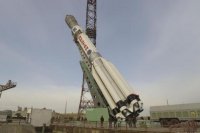 |
|
Proton moving into the vertical position |
By 8:30, the train was in front of the pad, ready for erection of the launcher into the vertical position. The operation was performed very smoothly and by 11:00, the launcher was clamped into the pad, ready for the service tower to be rolled back inside.
The remaining activities on the launch pad for the Integral team were all performed as planned:
- the air conditioning reconnection and all operations dealing with air cleanliness inside the fairing were witnessed during the day
- a sniff check for any potential hydrazine leakage from the Integral satellite was done via a trap in the upper stage, just below the fairing
- the tension of the clampband fixing the satellite to the upper stage was checked and found within specifications
 |
|
Proton launcher being rolled out of the 92-1 building |
Meanwhile, the satellite was also switched on remotely from the 92A-50 building and all stations were manned in preparation for the launch rehearsal on the 14th. Later in the day, the electrical team finished recharging the batteries.
So far, all systems are on track for the launch on 17 October.
11th October
Proton declared ready for rollout
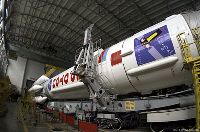 |
|
Proton launcher on the train waiting for rollout |
The commission's conclusions are positive and we are scheduled to witness the rollout on the 12th at 6:30 in the morning, local time.
Prior to the commission's meeting, work continued on the Proton itself. It was lifted from its integration rig and moved to a special railcar. The train is now complete and is formed by a locomotive, a thermal car, containing an air conditioning system and a vibration monitoring station and the Proton itself.
8 - 10 October
10 October
INTEGRAL ground segment declared ready
 |
|
ESOC Main Control Room |
Simulation tests covered the critical launch and early orbit phase, commission phase and routine phase activities as well as appropriate contingency recovery operations. The results showed that mission operations staff are fully trained and ready, and that the entire 'people/machines/procedures' system is able to execute reliably and correctly all planned INTEGRAL operations within the given time constraints.
The INTEGRAL Mission Operation Control (MOC) ground segment consists of:
- the MOC at ESOC with its mission operations control facilities
- the ground stations Redu in Belgium, Goldstone (DSS16) in California USA, Vilspa 2 in Spain and Perth, Australia
- the communication systems connecting the MOC with supporting ground stations and with the INTEGRAL Science Data Centre and the INTEGRAL Science Operation Centre
- the operational documentation for the satellite, flight dynamics and supporting ground facilities
- the databases for telemetry, telecomand, tracking, flight dynamics and ground facilities
Rollout of the Space Head Unit
The Space Head Unit (made up of the INTEGRAL satellite, separation systems, adaptors, fairing and Proton upper stage), was rolled out on 10 October at 10:15 Baikonur time to begin its short journey to the Launcher Integration Building about 500 m away. As always with a fuelled satellite and an upper stage, stringent safety precautions were implemented and the fire brigade and ambulance were present.
 |
 |
|
The Space Head Unit on its railcar leaving building 92A-50 |
The Space Head Unit inside the Launcher Integration Building |
A locomotive pulled the railcar with the Space Head Unit (SHU) into the building. Once the locomotive had exited from the other side of the building the SHU was lifted into position for mating with the first three stages of the Proton.
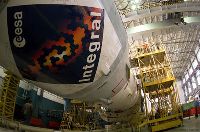 |
 |
|
Mating of the Space Head Unit with the first three stages of the Proton launcher |
The complete mated Proton launcher, with INTEGRAL safely inside the fairing |
Once mated, ESA and Alenia engineers verified the correct electrical continuity between the upper stage and the bottom of the Proton rocket. This connection will be used later on the pad to communicate with the satellite prior to liftoff. A test of the upper stage battery was also carried and proved successful.
8 October
Final Space Head Unit operations
Now that the INTEGRAL satellite is inside the fairing, the Proton launch authorities are driving the schedule of activities, according to their proven record of timely launches.
On 5 October, final operations were carried out on the fairing. This includes mechanical operations such as filling up access holes, fixing venting ports and some electrical checks.
 |
 |
|
Sticking on the INTEGRAL Logo |
Final operations on the fairing |
The INTEGRAL logo, brought over from ESTEC, was fixed on 7 October. The exact location of the logo generated a heated debate among the team. The logo should first fit on the fairing, be seen during transportation of the space head to the launcher and of course be visible on the launch pad, before lift off, from the observation point. After some discussion, lead ESA launcher interface engineer Barrie Henson found a suitable compromise with our Russian partners.
Once complete, the space head unit was lifted on 8 October by 2 cranes and loaded on a railcar, for transport to the Launcher Integration Building.
 |
 |
|
Loading of the space head unit on the railcar |
Fixing the space head unit to the railcar |
The Space Head will now leave the main spacecraft integration building (building 92A-50) where the INTEGRAL team has its offices. The team will now have to split into 3 groups. One group will follow the activities in the Launcher Integration building (building 92-1).
Others will start preparations in the launch pad and bunker (launch complex 200), while the packing team will remain here to start moving equipment back into their boxes and into sea containers for the return trip. It will be again a busy time in Baikonur.
Note: We have had the pleasure of welcoming Stephane Corvaja, our official ESA photographer.
30 September - 4th October
4 October
Baikonur celebrates Sputnik launch
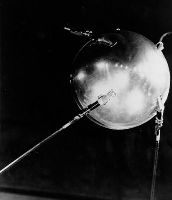 |
|
Sputnik 1 |
This historic satellite was launched from the Baikonur Cosmodrome in Kazakhstan, where ESA's Integral satellite is scheduled to be launched 10 days from now.
The name of the satellite was Sputnik, Russian for fellow traveller. This historic satellite was launched from the Baikonur Cosmodrome in Kazakhstan, where ESA's Integral satellite is scheduled to be launched 10 days from now.
Sputnik 1 was very unsophisticated, particularly compared to Integral. In appearance small round and spiky, it was an 83 kg aluminium sphere with a diameter of 58 centimetres and with four antennas, each nearly 3 metres long. On board were two radio transmitters on 20.005 and 40.002 MegaHertz and silver-zinc batteries, sufficient to provide one watt of power for up to three weeks.
 |
|
Baikonur celebrates the Sputnik anniversary. (click image to load a short video of the celebration) |
Once in orbit Sputnik began to transmit the first message received from space; although only a simple beep, beep, beep, this marked the beginning of space exploration.
This historic moment was marked in the town of Baikonur with a festival, complete with parades and a rock concert. The celebrations were complete when it was announced that the Russian Government will renew its lease of Baikonur from the Kazakh authorities for another 50 years.
3 October
Integral encapsulation
 |
|
The INTEGRAL Team |
Following the removal of the last remove-before-flight item, and visual inspection, the combined upper stage and satellite was raised just enough to allow Khrunichev personnel to place a load-bearing support underneath the upper stage. Once the support was adjusted into place, the bottom half of the fairing was slowly slid underneath INTEGRAL.
Great care was taken to make sure that static clearance between INTEGRAL and the fairing was acceptable. No problems were identified and finally the fairing was secured to the fourth stage.
In record time, the upper half of the fairing was craned into position and lowered into place. Soon afterwards Khrunichev personnel began fastening the two halves together, and adjusting the mechanical and pyrotechnic devices that will open the fairing once in space. This combination of Proton 4th stage, Proton adapter, satellite separation system, satellite and fairing is referred to as the Space Head Unit or SHU for short.
Once finalized, the SHU will be transported to Proton Facility 92-1 where it will be attached to the rocket.
2 October
INTEGRAL now horizontal
At approximately 16:05 Baikonur time the INTEGRAL project reached another milestone as the Proton 4th stage was successfully rotated into the horizontal position.
Following an inspection of the satellite by ESA and Alenia Product Assurance personnel, Khrunichev rotated the satellite and Proton 4th stage (Block DM) assembly from vertical to horizontal. This rotation is necessary to install the fairing over the satellite and to comply with train transportation of the rocket.
 |
 |
|
INTEGRAL being moved into a horizontal position |
Removal of Red-Tag Items |
There are now very few activities remaining on the satellite itself. In the next few hours, all 'remove before flight' items will be taken off and final checks of the clampband, that keeps the satellite fixed to the upper stage, will be carried out. Then, after tests by Khrunichev and Energia, the whole assembly will be positionned on a cradle aboard a train and transported to building 92-1 for mating with the rest of the Proton Rocket.
Once installed on the Proton, a new set of electrical checks and battery maintenance will be carried out before the final rollout to the pad.
30 September
INTEGRAL transfer
 |
|
A Happy Team |
Activities started at 10:00 with a final briefing between the Russian and the INTEGRAL team. The crane carried the spacecraft across the integration hall, lifted it above the Block DM and gently lowered it on top of the interface ring. By noon, all operations were completed, to the whole satisfaction of the team.
22-29 September
29 September
No water in town
 |
|
Children in Baikonur smile for the camera |
All water supply is cut off and water is distributed twice a day at certain points in the city. By 1 October it is expected that the complex network of hot and cold water pipes will be in operation again, ready to withstand the harsh winter cold.
 |
|
The INTEGRAL spacecraft and the Proton adapter |
Work is progressing on schedule and the spacecraft and its adaptor system are ready to be installed on the upper stage of the Proton, also known as Block DM. Despite the queues for water distribution (background), children are still at play in the streets of Baikonur.
25 September
Progress launch
 |
|
Launch of Progress cargo ship |
The launch was planned for 22:55 from the famous Gagarin pad, about 40 minutes by bus from the Integral team's area on the base. About one hour before lift off, buses trickled in onto a parking area, maybe 2 to 3 km from the launch pad. Staff from all over the cosmodrome, some with their families, and the Integral team, often referred to as 'foreign specialists', watched the pad attentively.
A Soyuz launch is a well-rehearsed event, that needs little explanation. On time, the launcher lit up the night sky, made a deafening noise and headed for space.
24 September
Start of combined operations
 |
|
The separation system being lowered on top of the Proton adaptor |
These elements are needed to fix the spacecraft to the launcher and to allow the spacecraft to separate from the launcher once in orbit.
This is just a first step in a series of activities that will lead to the final preparation of the so-called space head unit, which consists of:
- the integral spacecraft
- the separation system and the proton adaptor, as assembled today
- the Proton fairing to protect the spacecraft during the ascent
- the Energia block DM upper stage.
Once completed, a train will transport this whole unit to another building for final assembly of the first three stages of the Proton launcher.
22 September
Safety first
 |
|
Trying on an emergency hood |
Team members working close to Integral need to have at hand either gas masks or emergency hoods connected to an air bottle for breathing. Further safety measures are carried out in the clean room.
Everyday, the major parts of the Reaction Control System on the spacecraft are 'sniffed' with a portable instrument that reacts to traces of hydrazine. A detector has also been mounted on the spacecraft support stand.
1-21 September
21st September
Hydrazine loaded
 |
|
The Core Fueling Team |
Activities started at 9:29 in the morning when Martyn Kramer and Juan Flores-Watson, of Astrium UK, were the first to enter the clean room fully dressed in SCAPE suits. Martyn and Juan performed the loading, transferring the hydrazine from the two transfer tanks and then draining all the lines and hoses to a safe level.
SCAPE suits are used to protect the fuelling operators from the toxic effects of hydrazine. Working in these suits for long periods of time is cumbersome and a lot of preparation time is spent making sure breathing air, wireless communications and basic suit adjustment are as confortable as possible.
 |
|
Martyn Kramer being helped out of his SCAPE suit |
The spacecraft is now fully loaded ready for perigee raise manoeuvres and orbit or attitude corrections. Special thanks from the INTEGRAL project to the Astrium team and in particular to Martyn Kramer's triple performance as procedure writer, SCAPE operator and test conductor.
20 September
Proton preparations on track
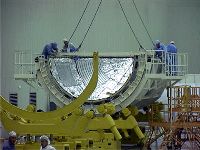 |
|
Close-up of the Proton fairing |
Activities take place in three buildings:
- in the Technical Complex, building 92A-50, the fairing is being assembled onto the integration rig
- in the main Proton integration hall in building 92-1, assembly of the three first stages is being completed
- in the Energia building, the block DM upper stage is in its final stages of preparation and will be fuelled soon
INTEGRAL will be mated to the upper stage in the main Protol integration hall. First it will be mated to the Proton adapter then lifted above the upper stage in the vertical position. Then the whole assembly (INTEGRAL and upper stage) will be tilted to the horizontal position for encapsulation into the fairing.
19 September
Functional tests completed
 |
|
All smiles now testing successfully completed |
It will take about eight hours to load 540 kg of hydrazine needed to put the spacecraft into a safe configuration. Fuelling is planned for Saturday 21 September. In the meantime, the fuelling team is carrying out the last preparations and checks of the fuelling equipment.
SCAPE suits are used to protect the fuelling operators from the toxic effects of hydrazine. Working in these suits for long periods of time is cumbersome and a lot of preparation time is spent making sure breathing air, wireless communications and basic suit adjustment are as comfortable as possible.
1 September
Mating completed
 |
|
The Integral Payload Modules |
The picture shows INTEGRAL prior to mating with both modules side by side. Lifting equipment is then used to lift the payload module shown in the middle of the image and gently lower it on to the service module shown on the right.
17-30 August
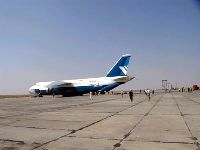 |
|
The INTEGRAL satellite safely arrives in Baikonur |
The satellite, shipped in two separate modules, was transported by road to Schiphol airport, where it was loaded in the cargo bay of an Antonov 124 aircraft. After a stopover in Moscow, it arrived on 24 August 2002 in Yubileiniy airport, in the center of the Cosmodrome. Finally, a train transferred the spacecraft containers from the airport to the integration facilities in building 92A-50. To avoid any shock to the spacecraft, this final leg took more than 6 hours for a distance of about only 20 kilometres.
30 August 2002
 |
|
The Reaction Control System (RCS) leak testing |
On 27 August, the cleanliness and humidity inside the tanks was verified. On the 28th, the system was pressurized with helium to 24 bars, the maximum expected operating pressure during flight. Overall leak testing started on the 29th, with the closing of the container lid. Helium inside the container is monitored and compared to an initial injection of a known quantity. Increase in helium concentration indicates that a leak is present. Helium concentration remained stable, proving that the system was leak tight. Following the test, the tanks were depressurised and the helium was exchanged for nitrogen.
29 August 2002
 |
|
The Payload Module (PLM) in vertical position |
24 August 2002
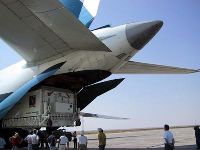 |
|
The INTEGRAL PLM container is unloaded from the Antonov |
- Antonov departure towards Baikonur at 5:45 Moscow time, almost two hours delay.
- Landing at 10:30 in the sunny Yubeleiniy airfield, lengthy manoeuvre to position the Antonov near the railway, exactly in the specified point. In the mean time all the welcome army is on the tarmac.
The unloading of the Service Module (SVM) container is slow with the placing of the metallic plates on the tarmac as sort of VIP carpet to smooth the rolling. The wind starts to build up and becomes very strong. Around 5 pm the train with the INTEGRAL load leaves the airfield towards the satellite processing facility. Unloading of the train upon arrival goes from 23:00 until 01:00. The Payload Module (PLM) and Service Module (SVM) containers are safely entered in Hall 101.
23 August 2002
 |
|
The INTEGRAL PLM container is unloaded from the Antonov |
-
Departure of convoy from ESTEC to Schiphol with Payload Module (PLM) and Service Module (SVM) early in the morning (4:30)
- Loading the containers between 8:30 and 12:00.
- Take off 16:40: the Integral escort is: Eliseo Balaguer and Arrien Tiemon from ESTEC and 3 Alenia team members.
- Moscow 22:00 local time, landing
- Parking place free at 23:00. The plane is serviced; weather checked, tires embarked and a new crewmember joins. This Antonov was continuously on the move in the last few days! Twice Milan-Leipzig with a cargo of 120 tonnes of sand sacks for the floods in Germany.
22 August 2002
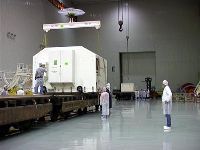 |
|
The Service Module container in building 92A-50 |
- In Schiphol (Amsterdam airport), arrival of Antonov in the afternoon. Different plane and crew from first shipment. Loading of the second Antonov with 3 sea containers
- In ESTEC, loading of the Payload Module (PLM) and Service Module (SVM) onto lorries and preparation for departure to Schiphol.
17 August 2002
 |
|
The European-Russian team taking a break after reloading the sea containers onto the train |
The INTEGRAL launch campaign has now fully started, with the arrival today at 10:30 (Baikonur time) at Baikonur's Yubileini airport, of more than 70 tonnes of support equipment by Antonov 124.
The large cargo aircraft was unloaded in just a few hours and by 14:00, all items were transferred to railcars, ready for the final trip to the integration building, known as building 92A-50. The support equipment consists of all the test and assembly tools needed to finalize and monitor the satellite before liftoff. The team is now anxiously waiting for the arrival of the INTEGRAL spacecraft, planned for next week.
Diary Author
Integral diary by our man in Baikonur
 |
|
Philippe in front of INTEGRAL |
Philippe has been involved with INTEGRAL for nine years, almost since the beginning of the project. His job is to overlook all the tests on the satellite, which is why he is now at Baikonur to supervise the final checks that must take place before INTEGRAL receives the OK for launch. This is a very busy period and the culmination of almost 10 years of work for all those involved on the project.
Philippe has promised to take time out to keep us up to date, both in words and pictures, with INTEGRAL's preparation for launch on board a Russian Proton rocket. The launch campaign commenced on 17 August with INTEGRAL's arrival - by air from Schipol in the Netherlands.
Baikonur Cosmodrome
This historic cosmodrome, built on the barren steppes of Kazakhstan, is still the world's largest space launch facility even after nearly 50 years.
Built in 1955, when Kazakhstan was part of the Soviet Union, Baikonur covers 6717 square km and extends 75 km from north to south and 90 km from east to west. The base contains dozens of launch pads, five tracking-control centres, nine tracking stations and a 1500 km rocket test range.
It was from Baikonur that the first satellite to orbit the Earth was launched, and from Baikonur that Yuri Gagarin, the first man to orbit the Earth, was launched into space and the history books in 1961. More recent cosmonauts include ESA astronauts Claudie Haigneri in October 2001 and Roberto Vittori in May 2002 both on missions to the International Space Station.
Altogether it took two years to build the complex and the city of Leninsk had to be built nearby to provide apartments, schools and facilities for the thousands of workers involved in the project. However, Baikonur, the name of a mining town 350 km away, was given to the spaceport to register Yuri Gagarin's historic mission. Eventually in the 1990s, former Russian president Boris Yeltsin renamed the city of Leninsk, Baikonur.
Baikonur has been used for all Soviet and CIS manned launches and for most lunar, planetary and geostationary orbit launches. Since 1993 Russia has rented Baikonur from Kazakstan.
More details of the launch complex and its history can be found at The Russian Space Web.


